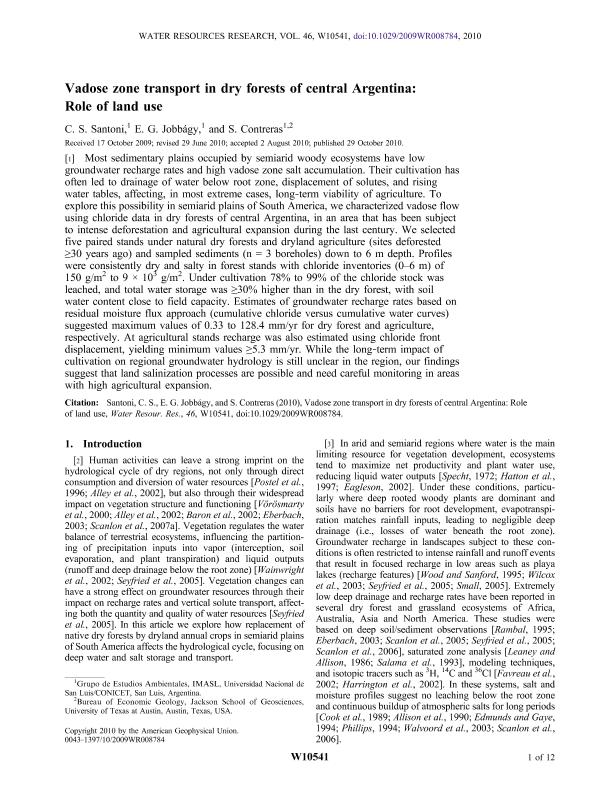Artículo
Vadose zone transport in dry forests of central Argentina: role of land use
Fecha de publicación:
10/2010
Editorial:
American Geophysical Union
Revista:
Water Resources Research
ISSN:
0043-1397
Idioma:
Inglés
Tipo de recurso:
Artículo publicado
Clasificación temática:
Resumen
Most sedimentary plains occupied by semiarid woody ecosystems have low groundwater recharge rates and high vadose zone salt accumulation. Their cultivation has often led to drainage of water below root zone, displacement of solutes, and rising water tables, affecting, in most extreme cases, long-term viability of agriculture. To explore this possibility in semiarid plains of South America, we characterized vadose flow using chloride data in dry forests of central Argentina, in an area that has been subject to intense deforestation and agricultural expansion during the last century. We selected five paired stands under natural dry forests and dryland agriculture (sites deforested ≥30 years ago) and sampled sediments (n = 3 boreholes) down to 6 m depth. Profiles were consistently dry and salty in forest stands with chloride inventories (0–6 m) of 150 g/m2 to 9 × 103 g/m2. Under cultivation 78% to 99% of the chloride stock was leached, and total water storage was ≥30% higher than in the dry forest, with soil water content close to field capacity. Estimates of groundwater recharge rates based on residual moisture flux approach (cumulative chloride versus cumulative water curves) suggested maximum values of 0.33 to 128.4 mm/yr for dry forest and agriculture, respectively. At agricultural stands recharge was also estimated using chloride front displacement, yielding minimum values ≥5.3 mm/yr. While the long-term impact of cultivation on regional groundwater hydrology is still unclear in the region, our findings suggest that land salinization processes are possible and need careful monitoring in areas with high agricultural expansion.
Palabras clave:
Vadose Zone
,
Recharge
,
Agriculture
,
Semiarid Woody Ecosystem
Archivos asociados
Licencia
Identificadores
Colecciones
Articulos(IMASL)
Articulos de INST. DE MATEMATICA APLICADA DE SAN LUIS
Articulos de INST. DE MATEMATICA APLICADA DE SAN LUIS
Citación
Santoni, Celina Sofia; Jobbagy Gampel, Esteban Gabriel; Contreras, S.; Vadose zone transport in dry forests of central Argentina: role of land use; American Geophysical Union; Water Resources Research; 46; 10; 10-2010; 1-10
Compartir
Altmétricas




